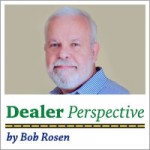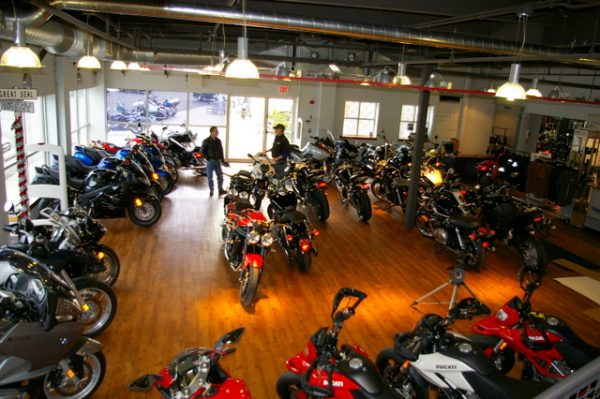 As motorcycle enthusiasts, we get a real kick out of accessorizing our rides, maintaining them, acquiring riding gear and occasionally buying a new or used bike. We have many choices of how and where we can scratch this itch, and local dealerships are always glad to provide an outlet for spending urges.
As motorcycle enthusiasts, we get a real kick out of accessorizing our rides, maintaining them, acquiring riding gear and occasionally buying a new or used bike. We have many choices of how and where we can scratch this itch, and local dealerships are always glad to provide an outlet for spending urges.
Dealers can attract customers with outstanding product selection, great customer service and attractive prices. A shortfall in any one of these areas means lost sales and, possibly, customers lost forever. Getting things right on the customer experience side is one thing; maintaining a financially-sound business while doing so is an entirely different matter.
As in all business, there is a constant tug of war between the push of profits generated by revenue (sales) and the pull of costs. It’s a battle to keep costs from consuming all the profits. Lose this battle and the resulting red ink can only be sustained for so long. This scenario spelled the end for approximately 4,000 dealers that have closed their doors since 2007.
Of course, savvy owners keep an eye on overall dealership financial performance. They track store revenue, costs and profits. In order to get a better handle on what’s really happening, it’s handy to look at the business in terms of individual “profit centers.”
In the motorcycle dealership that typically means the three primary business segments; a three-legged stool as it were – motorcycle sales, PG&A (parts, garments and accessories) and the service department.
In recent years, a fourth important revenue and profit center has been developed at many dealers in the areas of finance and insurance (F&I). For now, let’s focus on the three primary legs of the financial stool, beginning with a look at some basic terms.
“Revenue” is another word for sales measured in dollars and cents. “Cost of goods sold (COGS)” is the actual direct cost to the dealer for any item or service that is later resold to customers. “Gross margin,” expressed as a percentage of revenue, or dollars, is the amount remaining after the cost of an item or service has been accounted for.
For example, if an item is sold by the dealership for $100 and the cost of that item is $75, then the gross margin is $25 or 25%. Think of gross margin as money the dealer has left after paying the direct cost of items sold. This money will be used to pay the stores operating expenses which include salaries, rent or mortgage, utilities, insurance, taxes, maintenance, new equipment, etc. If the dealership has been careful with its money, there may even be some money left after paying the expenses – which we call profit.
There are quite a few other measurables that are used to evaluate a dealership’s operating performance. However, you can look at a dealers profit and loss statement and zero in on revenue, gross margin, overhead (operating expenses), and net profit to get a very quick snapshot of the financial health of the business.
An acceptable overall gross margin for the entire dealership is in the range of 20 percent. That means for every $1 million in revenue, the dealership has $200,000 to pay its operating expenses. The three main profit centers provide this money in different proportions:
Bike sales – For most dealerships, the largest revenue generator is the sale of new and pre-owned motorcycles. The sale of bikes can account for 75 percent or more of total revenue. For new bikes, manufacturers establish the cost of their bikes and publish an MSRP. So, one end of the gross margin equation is fixed (the cost) and the other end is variable (the selling price).
Manufacturers want their dealers to be successful and set costs and MSRPs to provide an attractive margin opportunity for the dealer. This margin disappears quickly as dealers discount, and more than a few dealerships have discounted their way out of business. Typical new motorcycle gross margin at full MSRP can range from 12 to 20 percent. These percentages will vary by brand and any dealer incentives that might be in place. As a result of discounting, actual gross margins are usually less.
The cost of pre-owned motorcycle inventory is simply what the dealership had to pay to acquire each bike (plus any refurbishment costs) – whether that be as a trade-in on a new bike sale or an outright purchase. In these cases, the dealer has more control over both the cost and selling side of the gross margin equation. As a result, we see higher gross margins on pre-owned bikes. Dealerships will typically strive for pre-owned bike gross margins in the range of 20-25 percent. As a result, dealers welcome the opportunity to build their pre-owned bike business.
PG&A – A strong PG&A department will go a long way to ensuring an overall acceptable financial picture for the dealership. Gross margins can vary widely as different suppliers establish their own individual cost and MSRP structures. PG&A gross margins can range from as low as 20 percent to 50 percent or more. Well-run dealerships typically average around 35 percent for their entire PG&A departments.
Service – Service is perhaps the most challenging department in any motorcycle dealership and is typically the smallest in terms of generating revenue. But it is responsible for the highest gross margin percentage in the dealership. Industry standards for service department gross margins hover around 65 percent.
As we look at the above numbers, we see that the way to a solidly profitable dealership travels down three different paths, each with their own unique challenges. In future columns, I’ll take a detailed look at each leg of the three-legged stool.
 Ride CT & Ride New England Serving New England, NYC and The Hudson Valley!
Ride CT & Ride New England Serving New England, NYC and The Hudson Valley!


